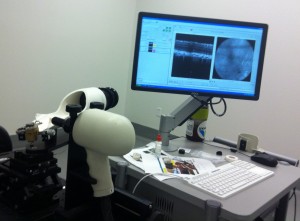Bioptigen Envisu R2200 Spectral Domain Ophthalmic Imaging System
(Also known as Optical Coherence Tomography (OCT) Scanner) Capabilities: Images up to 1.7mm deep in tissue (2.3mm in air) -1.6µm pixel resolution in tissue (2.3µm in air) -Equipped with three lenses • General Retina lens – for imaging of human*, or near-human size retina • Rat Retina lens – for imaging of rat retinal health • 12mm Telencentric Lens – for non-ocular tissue imaging – Detailed Specifications are provided on the Bioptigen webpage *(note: this device is not FDA approved for clinical use and we do NOT use this on live human subjects) Special Functions: Our Lab is equipped with an animal imaging kit specifically developed to aide in imaging of rat ocular tissues. • This includes a custom-built staging device to safely and repeatedly position rats for imaging • Specialized rat retina lens is tuned to rat anatomy & used to obtain the best possible images of rat retina. A custom positioning device has been developed in-house to allow imaging of the pia-arachnoid complex and outer surfaces of the brain. • This device has 3 axes of motion in a polar-coordinate system (phi, theta, and r) in order to allow for repeatable, custom positioning of any area of the brain. • When equipped with the 12mm Telencentric Lens, the positioning device can accommodate brains as small at rat to as large as adult human. (0-85mm radius travel)
Instron 5943 Mechanical Testing System
1kN, Electromechanical, Single Column Tabletop System for Low-Force Universal Testing Features: • Load measurement accuracy: +/- 0.5% of reading down to 1/1000 of load cell capacity option (2580 Series load cells) • Up to 2.5 kHz data acquisition rate option simultaneous on load, extension, and strain channels • Speed range of 0.05 – 2500 mm/min (0.002 – 100 in/min) • Customizable Control Panel • Compatible with Bluehill® Software • Automatic transducer recognition for load cells and extensometers • Small footprint saves space • Thousands of optional grips and fixtures • Full CE compliance
TA Instruments ARG2 Rheometer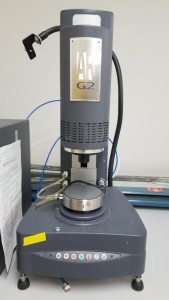
The AR-G2 is an advanced controlled stress, direct strain and controlled rate rheometer with a magnetic-levitation thrust bearing and a drag cup motor to allow nanotorque control. The magnetic bearing allows frictionless axial support and measurement of ultra low torques from 0.03 uN-m up to 200 mN-m with a resolution of 1 nN-m. Velocities up to 300 rad/s with a displacement resolution of 25 nrad can be applied; dynamic frequency range is 7.5 x 10(-7) to 628 rad/s. Temperature control is achieved using a Peltier plate. Custom environmental chambers and grip plates have been created for multiple unique biological applications.
Shock Tube
Capabilities: Our shock tube can generate pressure waves approximating the Friedlander waveform for blast research. 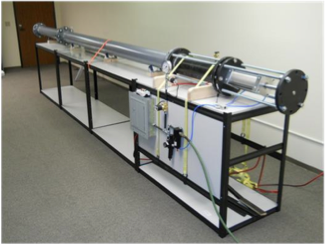 • Tube length of 15’ and internal diameter 6” • Driver overpressures ranging from 10 to 60+ PSI • Closed end or open ended testing • Diaphragm manually punctured using pneumatic activated arrowhead • Varied driver gases to create desired pressure profiles Instrumentation: 8 sensor ports along the length of the driven section of the tube allow for pressure measurements. • Pressure sampled at up to 1MHz • PCB Piezotronics pressure sensors
• Tube length of 15’ and internal diameter 6” • Driver overpressures ranging from 10 to 60+ PSI • Closed end or open ended testing • Diaphragm manually punctured using pneumatic activated arrowhead • Varied driver gases to create desired pressure profiles Instrumentation: 8 sensor ports along the length of the driven section of the tube allow for pressure measurements. • Pressure sampled at up to 1MHz • PCB Piezotronics pressure sensors
Optokinetic Tracking Behavioral Test Unit
Capabilities: This custom device was designed to assess functional visual acuity for animal studies. Rotating contrast grating causes head tracking behavior when acuity sufficient to see the pattern. 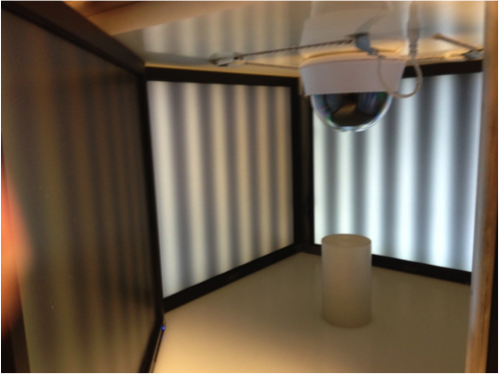 • Supports rat and mouse vision testing • 360 degree stimulation • Allows both light and dark adapted vision testing through the use of neutral density filters and infrared camera to track animal behavior Software: In-house Matlab program uses Psychtoolbox to present drifting stimulus across four computer monitors. • Testing algorithm designed to eliminate testing bias from knowledge of drift direction • Contrast of grating varied automatically in a 2 down 1 up algorithm to assess visual acuity threshold • Spatial Frequency and Rotation Speed can be varied to test specifications.
• Supports rat and mouse vision testing • 360 degree stimulation • Allows both light and dark adapted vision testing through the use of neutral density filters and infrared camera to track animal behavior Software: In-house Matlab program uses Psychtoolbox to present drifting stimulus across four computer monitors. • Testing algorithm designed to eliminate testing bias from knowledge of drift direction • Contrast of grating varied automatically in a 2 down 1 up algorithm to assess visual acuity threshold • Spatial Frequency and Rotation Speed can be varied to test specifications.
Olympus CX41 Upright Microscope
• Newly-developed infinity corrected Plan C Achromat objectives offer exceptional flatness producing sharp, clear images right up the edge of the field of view (4x, 10x, 40x, 100x oil). • Preset package economically priced for educational institutions (CX31 only). • F.N. 20 eyepieces (CX41 can be equipped with F.N. 20 or 22 eyepieces). • Anti-fungus treatment helps protect optical parts even in high humidity regions. • Inward-facing, quadruple (CX31), or quintuple (CX41) revolving nosepiece improves access and makes for quick, easy slide changes. • Fixed Abbe condenser NA 1.25, centerable and focusable for Köhler illumination. • A 6V/30W halogen bulb provides ample illumination for any observation. • Ergonomically designed frame with low positioned coarse and fine focusing controls, analyzer slot for linear polarized light (CX41 only), and convenient handgrips at the front and back for transportation; integrated field stop. • Built in left or right hand stage with rackless design (CX31 right hand only), low positioned X, Y controls with ergogrips to facilitate operation.
Olympus SZX16 Research Stereomicroscope
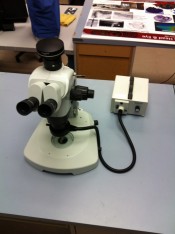 The SZX16 is designed for advanced research and has a maximum numerical aperture of 0.30, producing a resolution of 900 line pairs per millimeter. The SZX16 provides the largest zoom ratio of any stereo currently (April 2006) on the market 16.4:1. With this zoom ratio combined with a series of parfocal objectives (0.5x, 1x, 1.6x & 2x) the SZX16 can take you from macro to micro viewing.
The SZX16 is designed for advanced research and has a maximum numerical aperture of 0.30, producing a resolution of 900 line pairs per millimeter. The SZX16 provides the largest zoom ratio of any stereo currently (April 2006) on the market 16.4:1. With this zoom ratio combined with a series of parfocal objectives (0.5x, 1x, 1.6x & 2x) the SZX16 can take you from macro to micro viewing.
High-Performance Modeling Computers
Capabilities: The laboratory houses a number of high-performance computers utilized to perform mathematical & engineering analyses. Specifically these machines are dedicated to running complex Finite-Element (FE) codes. All machines are equipped with the following engineering analysis programs: • ABAQUS, ANSYS, & Hypermesh (FE Analysis) • Matlab (Mathematical Analysis) • Labview (Data Acquisition) • Solidworks (Computer-Aided Design) • Many other useful engineering softwares Machine Specifics: Primary Modeling PCs • Intel Core i7x-3930K 3.2 Ghz Hexa-Core CPU (12 virtual cores), 32GB DDR3 RAM, 1TB HDD, Nvidia Quadro Graphics with 2GB Dedicated VRAM • Intel Core i7x-980 3.33Ghz Hexa-Core CPU (12 virtual cores), 24GB DDR3 RAM, 1TB HDD, ATI Radeon HD 5700 Graphics with 1GB Dedicated VRAM Additional CAD/Modeling PCs • (4 PCs) – Intel Core i7 930 2.8Ghz Quad-Core CPU (8 virtual cores), 12GB DDR3 RAM, 1TB HDD, ATI Radeon HD 5700 Graphics with 1GB Dedicated VRAM • (1 PC) – Intel Core i7 3770 3.4Ghz Quad-Core CPU (8 virtual cores), 8GB DDR3 RAM, 1TB HDD, Nvidia Quadro Graphics Card with 2GB Dedicated VRAM

